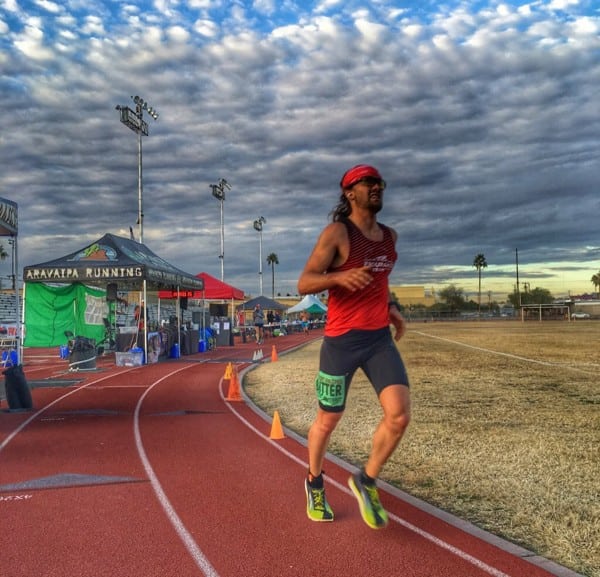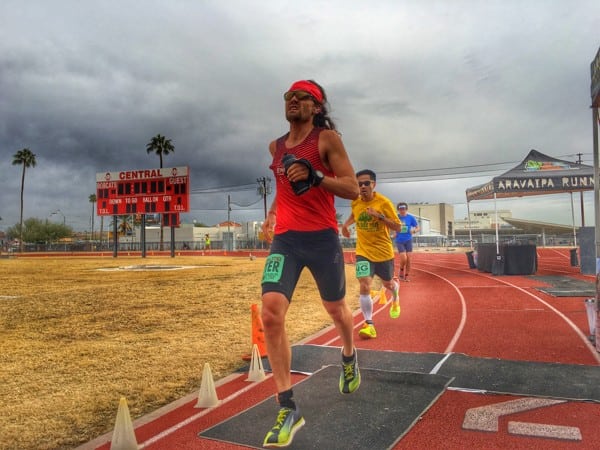[Editor’s Note: Last weekend, Zach Bitter set a new track 100-mile American record at 11:40:55. He held the previous record of 11:47:21, which he set two years ago.]
The Desert Solstice 100 Mile and 24 Hour Track Invitational is an event put on by Aravaipa Running, which targets fast times. As the name implies, it is on a track, which at first thought probably seems boring at best and inhumane at worst. So why?
When I first contemplated doing a track ultra, I dug into the history of it a bit. The first man I came across was Don Ritchie, a badass of epic proportions. For those unfamiliar, the man held the 100-mile world best for 25 years with a time of 11:30:51. More astonishing was the way he did it. I won’t get thick into the details, but the man split a 4:53:28 for 50 miles and 6:10:20 for 100 kilometers in shorter races of the same nature. Let me say that again. The man split a 4:53:28 for 50 miles and 6:10:20 for 100k!!! You can read detailed information on Don Ritchie on this website. This led to an intrigue that eventually had me looking into other flatlander greats such as Bruce Fordyce, Frank Bozanich, Yannis Kouros, Rae Clark, Oleg Kharitonov, and many more. I eventually ended on an article written about the current world-best performance of 11:28:03. This quote sums up what it must have been like to be at the Crystal Palace in London in 2002, when that record was set after a latest-race battle between Russians Oleg Kharitonov and Denis Jalybin:
“Kharitonov some four laps behind Jalybin incredibly began running 6 minutes [sic] miles — 93 miles into the race. Jalybin was struggling, pale and looking as if he would drop out.
“Jalybin clung on to the lead until the end of the 402nd lap, a mere 135 meters from the finish. Suddenly Kharitonov went by, pushing on to clock a new 100 mile world best of 11:28:03; just over 6:52.8 per mile. It was to take Denis Jalybin nearly two minutes to cover the last 135 meters whereupon he collapsed, looking very pale. Jalybin also broke the old mark, recording 11:29:32.” – American Ultra Association (full report)
The beauty of a track or any flat surface that remains relatively the same throughout history has been intriguing to me. It allows you to not only gauge specific improvements and regressions in performance, but also lets you race the greats of the past.
Another intrigue to me has been something that has been innate for some time, which is running at its most basic form. No need to navigate, dodge, hike, scramble, hurdle, and the like. Just run. Think of nothing but putting one foot in front of the other. Some, or I would venture to say most, may see this as boring or mundane. Certainly it is when compared to the trails and other more scenic venues, but it has its own freeing characteristics.
The track puts forth a final characteristic that cannot be matched: complete exposure. You cannot hide on a track. Every strength, weakness, and physical and mental struggle is on full display for whomever desires to watch. Watching these events has been just as fascinating to me as actually participating in them. Again, something which would at first thought seem incredibly boring reveals itself with an onset of intrigue and questions of how and what next.

Zach Bitter on his way to setting a track 100-mile American record at the 2015 Desert Solstice Track Invitational. All photos: Aravaipa Running
For this year’s Desert Solstice Track Invitational, I went in with the main goal of putting myself in position to break the world-best time of 11:28:03. My training leading up to the event went quite well and I felt as fit as ever for a 100-mile track race.
I was intrigued enough at what my potential was that I put a lot of thought into how to pace it. Eventually I knew one thing for sure. I didn’t want to finish the race asking if I had been too conservative in the beginning.
This led to a relatively aggressive start, but it felt right and I trusted my training. My first marathon of the day was 2:52:30 and I came through the 50-mile mark of the race at 5:33:30, which if replicated would have me over 21 minutes faster than Kharitonov in 2002. I knew this wouldn’t be the case as I assume at best a slight depreciation at events like this when the day’s long hours begin to tax both mentally and physically, but it was where I wanted to be. If things went well and I regressed a bit, I could still finish a solid 10 to 12 minutes ahead of the world record.
My next mini-goal to keep myself from getting too overwhelmed by the number of laps/miles remaining was to get to the 100k mark in under seven hours. I remained fairly consistent and reached 100k in a time of 6:58:00, which unbeknownst to me at the time was an track 100k American track record (not to be confused with Max King’s road 100k record of 6:27:43 set at the 2014 IAU 100k World Championships, which is still one of the best performances I’ve witnessed in person.
I was in a good place through 100k and very optimistic about the position I was in through nearly two thirds of the event.
As I focused on closing in on the 70-mile mark, things felt smooth, but as one would expect, the tolls of the day were starting to become more apparent. I had some time in the bank, so I didn’t worry about slight decreases in pace. In fact, it is this part of the race that can often become very exciting because you run a variety of finishing scenarios through your mind and pass the time with simple math calculations of current, past, and projected lap pace. With the exception of slight cramping in my right hamstring, which seemed to be kept at bay with extra electrolytes, I felt decent.

Zach during one of the direction switches.
The biggest noticeable barrier came at hour eight. On the track, you switch directions every four hours, which is typically a huge benchmark in these events and a source of motivation. Mentally it was, but physically the next few laps felt like I was trudging through molasses. I’m not sure if it was the aggressive early miles or not, but my time slowed.
As I came through mile 80, I did some mental math and realized I need to average approximately a seven-minute mile to set a world best. Mentally, this was motivating and I began to make a bit of a surge. I thought to myself that if you had told me at the beginning of the week that I would get to mile 80 needing seven flats, I would have taken it in a heartbeat.
This final surge was fleeting, however, and my muscles began to break down beyond what I could push through. I could feel my form breaking down and pictures confirmed that I was leaning way back and not running with ideal form, which I’m sure exacerbated the slow down.
The final 15 miles felt like an eternity, but I was able to keep it together enough to get a 100-mile PR and lower my own track 100-mile American record by six minutes and 26 seconds. By the end, I was barely holding off the right-hamstring cramping and it immediately tightened up as I reached the 100-mile mark and began to slow down. I had no choice but to lay down.
The best part of this sport is taking your experience and learning from it. Every race is valuable regardless of outcome as it provides you with new intelligence for future progress. I think I learned more from this race and build-up than any other event.
Things I learned:
- In the future, I need longer tempo/progression efforts. I feel like this would give me the needed strength to hold up muscularly the final 15 miles.
- I need to be more strategic with timing of posterior-chain strength work (hamstrings and glutes). Something I will definitely focus on this winter.
- I knew this going into the event, but lane two adds up. When doing 100 miles within a 24-hour event, passing in lane two is inevitable. It’s part of the game, though, if you want to do it within a longer timed event. My Strava data clocked 104.7 miles, which a healthy chunk of is GPS error. In training, I calculated it to produce a bonus of eight to 10 seconds per mile when doing workouts on a track. This information has me excited for future events where hugging lane one is possible.
- I can’t thank Aravaipa Running enough for putting on such a cool event. They are top notch in planning and executing. Rich McKnight, my crew chief and a true disciple of the sport, was phenomenal in helping me get what I needed before, during, and after the event. The inspiring performances by the other competitors was a huge motivating factor both during the event and in spectating.
- Finally, a big thanks to my sponsors Altra Footwear, Drymax Socks, Orange Mud, Extreme Endurance, and Vespa OFM for believing in me and helping me explore my limits and reach for new ones.

Laying down after setting his record.
